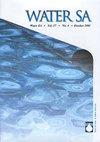监测低toc和低氯网络中卤化乙酸(HAAS)的季节性变化并评估对公共卫生的风险:muul, t rkiye病例
IF 1.2
4区 环境科学与生态学
Q4 WATER RESOURCES
引用次数: 0
摘要
氯不仅可以去除水中的寄生病原微生物,而且由于与原始水源中的天然有机物(NOMs)发生反应,还会形成可能对人类致癌的消毒副产物(DBPs)。卤乙酸(HAAs)是文献中最著名和最常见的消毒副产物群(DBPs)之一。在美国环境保护署的风险定义中,它的一些成分已被确定为致癌物质。因此,在确定对公众健康可能产生的影响方面,确定水中HAA浓度和进行风险分析是非常重要的。本研究旨在监测本文章由计算机程序翻译,如有差异,请以英文原文为准。
Monitoring seasonal variations of haloacetic acids (HAAS) in low-TOC and low-chlorine networks and assessing risk to public health: Muş, Türkiye case
Chlorine not only removes parasitic pathogenic microorganisms in water, but also causes the formation of disinfection by-products (DBPs) that can be carcinogenic to humans, due to reacting with natural organic matter (NOMs) in raw water sources. Haloacetic acids (HAAs) are one of the most well-known and common disinfection by-product groups (DBPs) in the literature. In the risk definitions of the EPA, some of its components have been identified as carcinogenic. Therefore, determination of HAA concentration in water and execution of a risk analysis are very important in terms of determining the possible effects on public health. This study aimed to monitor the seasonal and spatial variations of haloacetic acids (HAAs) in 2 different water supplies (surface and groundwater) serving the city center of Muş Province, Türkiye, and to demonstrate their public health implications. In this context, an analytical study was conducted covering 4 seasons. According to the results, although the amount of NOM in water bodies was less than 1 mg‧L−1, the HAA5 content may occasionally exceed the USEPA limits of 60 µg‧L−1, but did not exceed the Canadian 80 µg‧L−1 limit. When the WHO limit values were examined on a component basis, it was determined that the MCAA concentrations in both water sources sometimes exceeded the limit of 20 µg‧L−1 in the July and October sampling periods. The risk level related to maximum DCAA level in the main network by means of ingestion pathway was found to be 18.7 times higher for women and 16.5 times higher for men when compared with USEPA risk criteria. Also, in the Muratpaşa water network, risk from DCAA exceeds the USEPA risk level 15.2-fold in women and 13.4-fold in men. However, since it was also found that the level of free chlorine in the network does not meet the required level, it should be noted that there may be an increase in the risk level if there is adequate chlorination in the supply.
求助全文
通过发布文献求助,成功后即可免费获取论文全文。
去求助
来源期刊

Water SA
环境科学-水资源
CiteScore
2.80
自引率
6.70%
发文量
46
审稿时长
18-36 weeks
期刊介绍:
WaterSA publishes refereed, original work in all branches of water science, technology and engineering. This includes water resources development; the hydrological cycle; surface hydrology; geohydrology and hydrometeorology; limnology; salinisation; treatment and management of municipal and industrial water and wastewater; treatment and disposal of sewage sludge; environmental pollution control; water quality and treatment; aquaculture in terms of its impact on the water resource; agricultural water science; etc.
Water SA is the WRC’s accredited scientific journal which contains original research articles and review articles on all aspects of water science, technology, engineering and policy. Water SA has been in publication since 1975 and includes articles from both local and international authors. The journal is issued quarterly (4 editions per year).
 求助内容:
求助内容: 应助结果提醒方式:
应助结果提醒方式:


